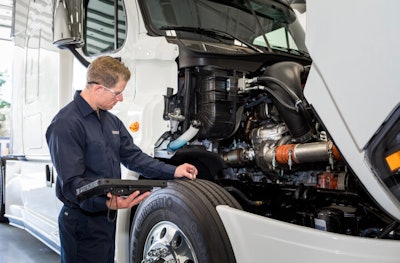
Having critical information through telematics can provide fleets with a more competitive edge and that’s particularly true during market downturns.
However, according to Penske Transportation Solutions, it’s mostly smaller fleets that are staying on the sidelines instead of jumping into the growing and critical arena of real-time actionable data.
Penske’s 2022 Telematics Use and Trends report reveals that 54% of large fleets, 51% of medium fleets and 37% of small fleets use telematics. Large fleets continue to adopt telematics at a higher rate than small and medium fleets.
Samantha Thompson, Penske Transportation Solutions vice president of customer success and fleet telematics, said that while upfront costs can be intimidating and telematics offerings not as plentiful as they are for larger fleets, she believes that smaller carriers need to get off the sidelines and get in the game.
“They do [need to acquire telematics] but their margins are thin, right?” Thompson said. “Small fleets have to justify the cost, and many of them go in expecting an immediate ROI. In some cases they can get that, but often it takes a few months or even a year plus to actually get the full ROI from the system that you purchased.”
The Software as a Service (SaaS) model is making telematics more affordable and more appealing to fleets large and small, Thompson said.
“It makes it significantly easier for those smaller fleets to adopt,” Thompson explained. “But the challenge is that these telematics providers don't necessarily make it easy for the small fleets because they say, ‘Hey, you have to have at least 10 or 20 trucks for me to even talk to you.’
“Well, that doesn't reflect the industry,” Thompson continued. “The industry is still very much small private fleets. And so [telematics providers] end up getting themselves out of the market because they don't pay attention to those small fleets.”
While Penske is more known for its truck leasing services, its telematics-related services are growing in popularity. The Pennsylvania-based company works with multiple telematics service providers and in turn uses collected data to help fleets improve vehicle uptime and driver behavior relative to speed, braking events, hours of service management and more.
In addition to equipment location, load visibility, truck condition and maintenance needs, fuel savings are typically the biggest attraction for fleets that sign up for telematics.
“Large fleets are saving millions of dollars in fuel by just monitoring driver behavior and coaching drivers to do better in the cab and treat the vehicles better, not to speed, no hard braking and so on,” Thompson said. “They are saving millions of dollars in fuel every year with telematics in place and so that's still the top driver as far as ROI goes.”
But monitoring trucks and drivers and prioritizing that incoming data often requires additional analytical programs and people with a talent for making sense of the numbers.
“The last five or six years, we've seen more and more customers that are dedicating a person to this type of analytics,” said Brandie Searle, vice president of digital product management for Penske Transportation Solutions. “Those customers that have that dedicated person or that dedicated team can go further with the decision making. Those customers that don't have a dedicated person may require the information to be put in a more simpler manner and maybe can't go quite as in depth as those customers that do have a dedicated person or team.”
If smaller carriers do elect to add telematics to their fleet management approach, they’re not typically adding people and programs to make the most out of their data.
“You won’t see a small fleet doing a whole lot of that,” Thompson said. “Typically, they're utilizing the tools that are inside the telematics platform and relying on that to provide the visibility.”
Fleets that don’t put specialists and analytical tools to work on their data streams tend to get data fatigue, Thompson said.
“What they need are actionable insights. ‘Tell me what I need to know right now. Don't make me drill down through all of this information you're putting in front of me,’” she said.
Not being able to access and make sense of truck and driver data can mean losing out on revenue which Thompson said isn’t much of an option anymore.
“Telematics has gone from just being an expense that might be helpful to being integral to a lot of fleets operations,” she said. “They can't manage their fleet without it.”









